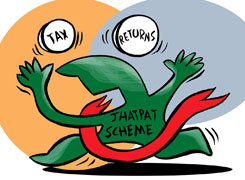Ramalingam Kalirajan |8191 Answers |Ask -Follow
Mutual Funds, Financial Planning Expert - Answered on Jul 02, 2024
He has an MBA in finance from the University of Madras and is a certified financial planner.
He is the director and chief financial planner at Holistic Investment, a Chennai-based firm that offers financial planning and wealth management advice.... more

Hi, I'm 47, divorced, living with dependent parents. I quit my job 2 years back to take up entrepreneurship venture which is not going well and will be exiting soon. Only financial back up I have is an ancestral property worth 3Cr. Can you advise on how can I best to invest the proceeds from sale of this property to generate regular monthly income and also grow corpus for retirement?
Your Financial Landscape
At 47 years old and with dependent parents, it's crucial to establish a stable income. Transitioning from an entrepreneurial venture that didn’t pan out can be challenging, but with careful planning, you can create a secure financial future.
Proceeds from Property Sale
The Rs. 3 crore from selling your ancestral property is a substantial amount. We’ll allocate it across various investment avenues to ensure diversification, stability, and growth.
Investment Strategy for Regular Income and Growth
Fixed Deposits and Savings Instruments
Fixed Deposits (FDs): Allocate a portion of your funds to FDs. They offer safety and guaranteed returns. FDs can provide a stable monthly interest income.
Senior Citizens' Savings Scheme (SCSS): If you or your parents are eligible, consider SCSS. It offers higher interest rates and is a secure option.
Debt Mutual Funds
Debt Mutual Funds: These funds invest in fixed-income securities. They are less volatile and offer steady returns. Opt for a mix of short-term and long-term debt funds to balance liquidity and yield.
Monthly Income Plans (MIPs)
Monthly Income Plans: MIPs are hybrid mutual funds with a mix of debt and equity. They aim to provide regular income through dividends and interest from bonds.
Systematic Withdrawal Plans (SWP)
SWP in Mutual Funds: Invest a lump sum in mutual funds and set up an SWP. This will provide regular monthly income while allowing the remaining investment to grow.
Diversified Equity Mutual Funds
Equity Mutual Funds: These funds invest in stocks and have the potential for higher returns. Consider large-cap, mid-cap, and multi-cap funds for diversification. Equity funds are suitable for long-term growth and can help build your retirement corpus.
Hybrid Funds
Hybrid Mutual Funds: These funds invest in both equities and debt instruments. They offer balanced risk and reward. Hybrid funds are ideal for moderate risk tolerance and provide a blend of growth and income.
Liquid Funds
Liquid Funds: These funds invest in short-term debt instruments. They offer better returns than a savings account and provide high liquidity. Keep a portion of your funds here for emergencies or short-term needs.
Understanding Mutual Funds
Categories of Mutual Funds
Equity Funds: High-risk, high-reward. Ideal for long-term goals.
Debt Funds: Lower risk, steady returns. Suitable for stability and income.
Hybrid Funds: Balanced risk, combining equity and debt. Good for moderate risk tolerance.
Liquid Funds: Very low risk, highly liquid. Ideal for short-term parking of funds.
Advantages of Mutual Funds
Diversification: Spreads risk across various assets.
Professional Management: Managed by experts.
Liquidity: Easy to enter and exit.
Flexibility: Various options to match your goals.
Tax Efficiency: Potential tax benefits.
Power of Compounding
Compounding is when your earnings generate more earnings. It works best with long-term investments. The earlier you start, the more you benefit.
Risk and Return
Balancing risk and return is key. Higher returns typically involve higher risk. Diversify your investments to spread risk and enhance potential returns.
Active vs. Passive Funds
Active Funds
Managed by fund managers aiming to outperform the market.
Higher fees due to active management.
Potential for higher returns.
Passive Funds (Index Funds)
Track a market index.
Lower fees.
Limited potential to outperform the market.
May not suit all investors.
Direct vs. Regular Funds
Direct Funds
No intermediary commissions.
Lower expense ratio.
Requires more investor knowledge.
Suitable for experienced investors.
Regular Funds
Invested through intermediaries like Certified Financial Planners.
Higher expense ratio due to commissions.
Professional guidance and support.
Suitable for less experienced investors.
Balancing Immediate Needs and Long-Term Goals
Generating Regular Monthly Income
Your primary need is regular monthly income. Here's how you can achieve that:
Allocate a portion to FDs and SCSS: Provides stable interest income.
Invest in Debt Mutual Funds and MIPs: Offers steady returns and income through dividends.
Set up SWP in Mutual Funds: Ensures regular cash flow while allowing growth.
Growing Your Retirement Corpus
For long-term growth, focus on equity and hybrid funds:
Diversify across Equity Mutual Funds: Large-cap, mid-cap, and multi-cap funds.
Balance with Hybrid Funds: Offers a mix of growth and stability.
Reinvest a portion of your monthly income: Enhances compounding effect.
Periodic Review and Adjustment
Regular Monitoring
Regularly monitor your investments to stay on track. Market conditions change, and your financial needs may evolve. Adjust your portfolio as needed.
Consulting with a Certified Financial Planner
Periodic consultations with a Certified Financial Planner provide valuable insights. They help align your investments with your goals and market conditions.
Emergency Fund
Keep a portion of your funds in liquid assets like liquid funds or savings accounts. This ensures you have quick access to cash for emergencies.
Tax Planning and Insurance
Tax Efficiency
Effective tax planning enhances your savings. Invest in tax-efficient instruments and utilize benefits under various sections.
Insurance Coverage
Ensure you have adequate insurance for life, health, and critical illness. This protects you and your family from unforeseen expenses.
Final Insights
Investing Rs. 3 crores from the sale of your ancestral property requires a balanced approach. Focus on generating regular monthly income and growing your retirement corpus. Diversify across fixed deposits, debt mutual funds, monthly income plans, and equity mutual funds. Use systematic withdrawal plans for steady cash flow. Regularly review and adjust your investments. Consulting with a Certified Financial Planner can provide valuable guidance. Start early, stay disciplined, and keep a long-term perspective.
Best Regards,
K. Ramalingam, MBA, CFP
Chief Financial Planner
www.holisticinvestment.in
You may like to see similar questions and answers below
Ramalingam Kalirajan |8191 Answers |Ask -Follow
Mutual Funds, Financial Planning Expert - Answered on Jul 11, 2024
Ramalingam Kalirajan |8191 Answers |Ask -Follow
Mutual Funds, Financial Planning Expert - Answered on Oct 10, 2024
Ramalingam Kalirajan |8191 Answers |Ask -Follow
Mutual Funds, Financial Planning Expert - Answered on Feb 04, 2025
Ramalingam Kalirajan |8191 Answers |Ask -Follow
Mutual Funds, Financial Planning Expert - Answered on Feb 20, 2025
T S Khurana |436 Answers |Ask -Follow
Tax Expert - Answered on Apr 05, 2025
Mayank Chandel |2167 Answers |Ask -Follow
IIT-JEE, NEET-UG, SAT, CLAT, CA, CS Exam Expert - Answered on Apr 05, 2025
Mayank Chandel |2167 Answers |Ask -Follow
IIT-JEE, NEET-UG, SAT, CLAT, CA, CS Exam Expert - Answered on Apr 05, 2025
Mayank Chandel |2167 Answers |Ask -Follow
IIT-JEE, NEET-UG, SAT, CLAT, CA, CS Exam Expert - Answered on Apr 05, 2025
Ramalingam Kalirajan |8191 Answers |Ask -Follow
Mutual Funds, Financial Planning Expert - Answered on Apr 05, 2025
Radheshyam Zanwar |1517 Answers |Ask -Follow
MHT-CET, IIT-JEE, NEET-UG Expert - Answered on Apr 05, 2025

There is little chance of getting admission to the mentioned institutions but you can get admission to IIITs. Yet, they participate in the counseling process. Please try to score in the 2nd attempt of JEE (Mains) for sure-shot admission. Best of luck to you.
Follow me if you like the reply.
Radheshyam
Chance to get admission to your home state IIITs. E.g. IIITDM Kancheepuram and the IIIT Tiruchirappalli (IIIT Trichy). But if you want to leave your home state, you can also get admission to other IIITs. Best of luck to you.
Follow me if you like the reply.
Dr Upneet Kaur |28 Answers |Ask -Follow
Marriage counsellor - Answered on Apr 04, 2025
Milind Vadjikar |1153 Answers |Ask -Follow
Insurance, Stocks, MF, PF Expert - Answered on Apr 04, 2025
Prof Suvasish Mukhopadhyay |544 Answers |Ask -Follow
Career Counsellor - Answered on Apr 04, 2025
Nayagam P P |4411 Answers |Ask -Follow
Career Counsellor - Answered on Apr 04, 2025

























